
A wedding is a ceremony where two people are united in marriage. Wedding traditions and customs vary greatly between cultures, ethnic groups, races, religions, denominations, countries, social classes, and sexual orientations. Most wedding ceremonies involve an exchange of marriage vows by a couple, presentation of a gift, and a public proclamation of marriage by an authority figure or celebrant. Special wedding garments are often worn, and the ceremony is sometimes followed by a wedding reception. Music, poetry, prayers, or readings from religious texts or literature are also commonly incorporated into the ceremony, as well as superstitious customs.

A wedding dress or bridal gown is the dress worn by the bride during a wedding ceremony. The color, style and ceremonial importance of the gown can depend on the religion and culture of the wedding participants. In Western culture, the wedding dress is most commonly white, a fashion made popular by Queen Victoria when she married in 1840. In Eastern cultures, brides often choose red to symbolize auspiciousness.
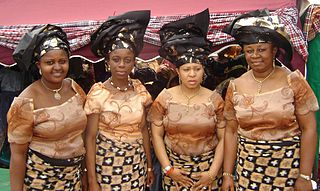
The wrapper, lappa, or pagne is a colorful garment widely worn in West Africa by both men and women. It has formal and informal versions and varies from simple draped clothing to fully tailored ensembles. The formality of the wrapper depends on the fabric used to create or design it.

The traditional Vietnamese wedding is one of the most important ceremonies in Vietnamese culture, which is influenced by Confucian and Buddhist ideologies.
Iranian wedding, also known as Persian wedding, consists of traditions rooted in Zoroastrianism, the primary religion of pre-Islamic Iran. Though the concepts and theories of marriage have been changed by Islamic traditions, the ceremonies have remained more or less the same as they were originally in pre-Islamic Iran. Although modern-day Iran is a multi-ethnic country, Iranian wedding traditions are embraced by the majority of ethnic groups in Iran.
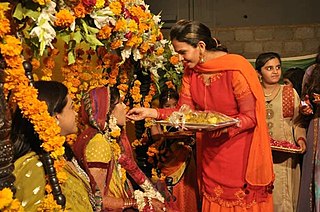
Marriage in Pakistan pertains to wedding traditions established and adhered by Pakistani men and women. Despite their local and regional variations, marriages in Pakistan generally follow Islamic marital jurisprudence. Marriages are not only seen as a union between a husband and a wife, but also an alliance between their respective families. These traditions extend to other countries around in the world where Overseas Pakistani communities exist.

Punjabi wedding traditions are a strong reflection of Punjabi culture with ritual, song, dance, food, and dress that have evolved over centuries.
A Brunei Malay wedding has many types of ceremonies.
Pakistani clothing refers to the ethnic clothing that is typically worn by people in the country of Pakistan and by Pakistanis. Pakistani clothes express the culture of Pakistan, the demographics of Pakistan, and cultures from Punjab, Sindh, Balochistan, Khyber Pakhtunkhwa, Gilgit-Baltistan, and Kashmir regions of the country. The clothing in each region and culture of Pakistan reflect weather conditions, way of living, the textiles and embroidery used and its distinctive style which gives it a unique identity among all cultures.
Arabic weddings are ceremonies of matrimony that contain Arab influences or Arabic culture.
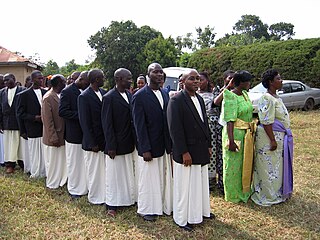
A kanzu is a white or cream coloured robe worn by men in the African Great Lakes region. It is referred to as a tunic in English, and as the Thawb in Arab countries. The kanzu is an ankle or floor length garment. It serves as the national costume of Tanzania as well as the Comoros, where it is called/pronounced 'Kandu' as well as thawb. The robe is also worn in some coastal Muslim regions of Tanzania and Kenya. The men of Uganda consider it their most important dress. Kanzu is a Ganda word of Swahili origin, which means "robe" or "tunic". In Tanzania, the term is used interchangeably with kaftan.
In the United States and Canada, weddings follow traditions often based on religion, culture, and social norms. Most wedding traditions in the United States and Canada were assimilated from other, generally European, countries. Marriages in the U.S. and Canada are typically arranged by the participants and ceremonies may either be religious or civil. There is a tradition that the prospective bridegroom ask his future father-in-law for his blessing.

Indian wedding clothes are elaborate set of clothes worn by the bride, bridegroom, and other relatives attending the wedding.
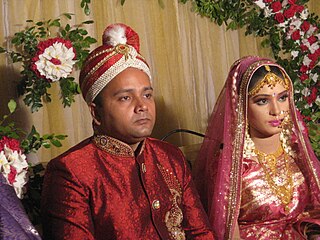
Muslim marriage and Islamic wedding customs are traditions and practices that relate to wedding ceremonies and marriage rituals prevailing within the Muslim world. Although Islamic marriage customs and relations vary depending on country of origin and government regulations, both Muslim men and women from around the world are guided by Islamic laws and practices specified in the Quran. Islamic marital jurisprudence allows Muslim men to be married to multiple women.

The national costume of Indonesia is the national attire that represents the Republic of Indonesia. It is derived from Indonesian culture and Indonesian traditional textile traditions. Today the most widely recognized Indonesian national attires include batik and kebaya, although originally those attires mainly belong within the island of Java and Bali, most prominently within Javanese, Sundanese and Balinese culture. Since Java has been the political and population center of Indonesia, folk attire from the island has become elevated into national status.

The Azerbaijani wedding tradition is one of the most significant and solemn family traditions of Azerbaijani people. It is multi-stepped, and is related to various compulsory rituals and traditions. Ancient Azerbaijani weddings reflect cycles of traditions, lasting for a long period of time, and need significant material costs.

The boubou or grand boubou is a flowing wide-sleeved robe worn across West Africa, and to a lesser extent in North Africa, related to the dashiki suit.

Bazin is a West African fabric with its origin in Mali, made from hand-dyed cotton, resulting in a damask textile known for its stiffness and vibrant sheen. It is primarily recognized as the most commonly used fabric for crafting a Boubou, a long, loose traditional outerwear worn by both men and women, particularly in West Africa. Another popular name for this fabric, especially among Hausa speakers, is Shadda.
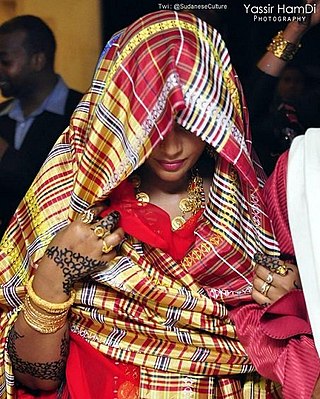
Marriage in Sudan is a fundamental social institution governed by Islamic law and Sudanese culture. Three types of marriages are recognized: traditional, civil, and religious. Arranged marriages are common, with parents typically arranging unions. Child marriage is an issue, with some exceptions to the legal age. Domestic violence has been a concern, particularly against women.















